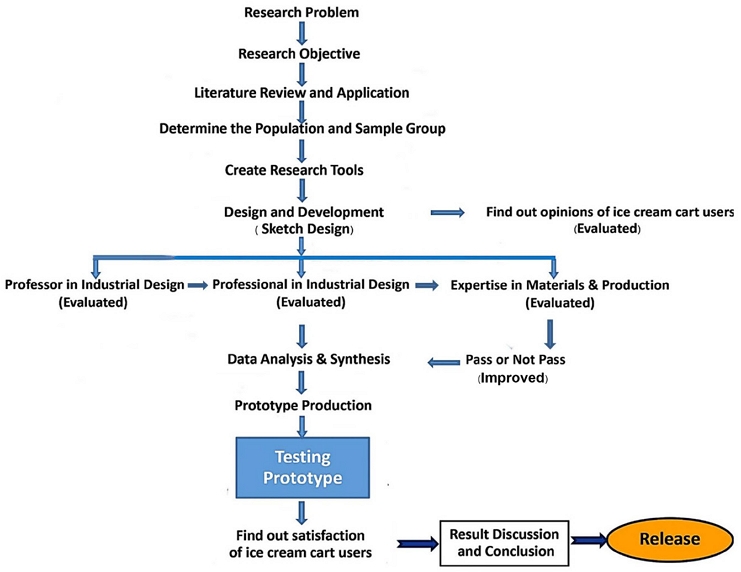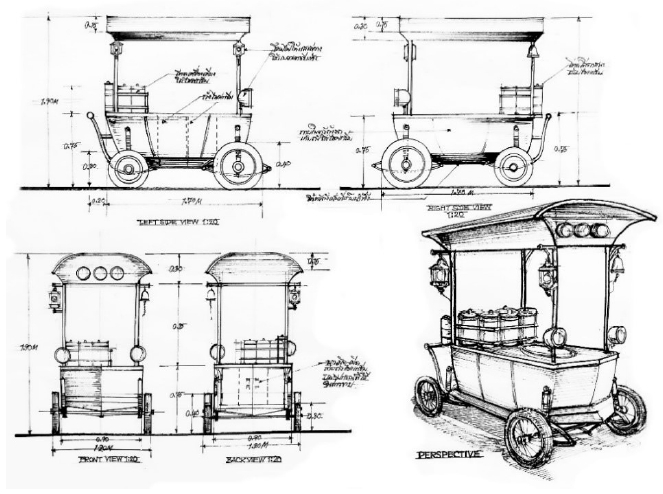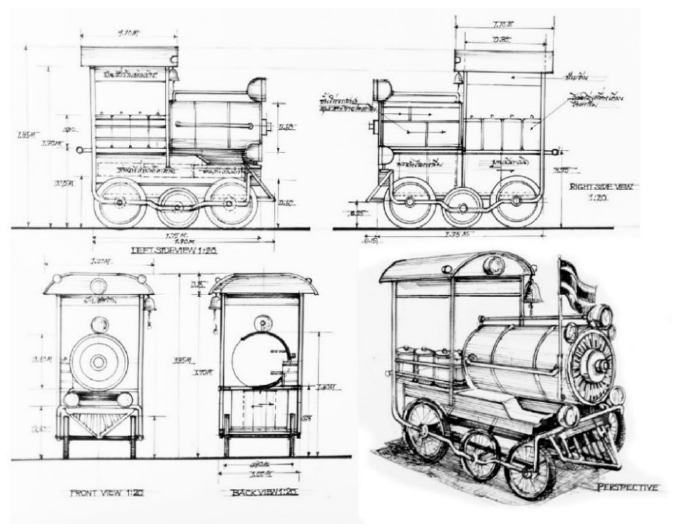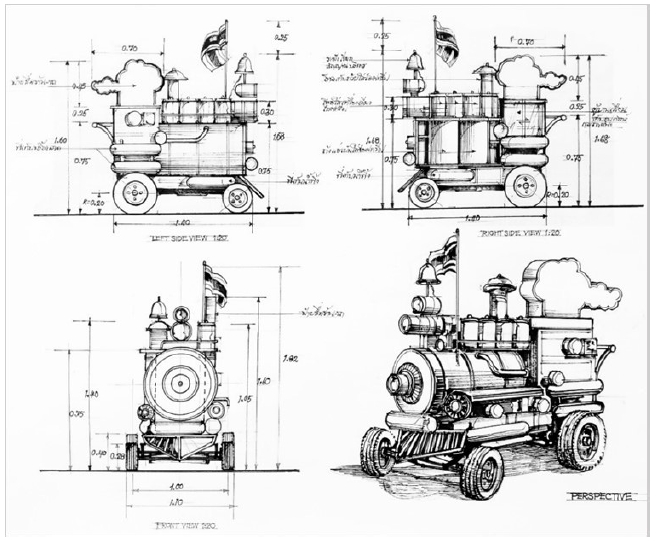
Design and Development of an Ice Cream Cart by Upcycling Automobile Scraps to Promote Street Food Vendors (StartUp) in Bangkok, Thailand
Abstract
Background Thailand’s Prime Minister has expressed strong support for recycling automobile scraps to address waste from aged vehicles and to reduce steel imports. Upcycling is a viable solution to reduce scrap automotive parts volume. The Design and Engineering Consulting Center (DECC) is developing eco-friendly street food cart innovations to provide at least 100 eco-friendly carts at cost-effective price points. The Government Savings Bank has also provided low-interest loans for purchasing carts made from upcycled materials because they are environmentally friendly, aiming to empower aspiring entrepreneurs.
Methods The research methodology comprised three sequential steps. Step 1 was the design and development phase using the principles framework of Henry Dreyfuss’s Designing for People: Five Formulas Applied to Green Design. The research tool was a questionnaire on three sketch designs of ice cream carts made of scrap cars. Step 2 was an evaluation by experts. The questionnaire was evaluated by six experts: two academics in industrial design, two professionals in industrial design, and two experts in materials science and production engineering. Step 3 was the assessment of user satisfaction. The sample group included 350 people. A prototype of an ice cream cart with a questionnaire was used as a research tool and was evaluated in real-world situations by 250 ice cream consumers and purposive sampling of 100 ice cream vendors.
Results The findings revealed the outcomes of an assessment concerning the design of the type C ice cream cart, made from automobile scraps, as evaluated by a panel of six experts. This comprehensive evaluation encompassed diverse facets, including utility and practical functionality, aesthetic appearance, durability, ease of maintenance, energy efficiency, use of environmentally friendly materials, sales appeal, and reasonable product price. The average mean score for these attributes was 4.50, indicative of a very good rating. Moreover, the study solicited input from a sample pool consisting of 100 ice cream vendors and 250 ice cream consumers, with assessments centered on various criteria, namely, aesthetic appearance, utility and practical functionality, durability, safety, ease of maintenance, environmentally friendly, reasonable product price, and ability to engender sales appeal. The average mean rating for these criteria stood at 4.53, signifying a very high level of satisfaction among the participants.
Conclusions The evaluation of ice cream cart vendors and buyers towards the prototype of the ice cream cart across all dimensions yielded a remarkable mean score of 4.53, signifying a very high level of satisfaction. Most satisfied in terms of Sales appeal, Utility and practical functionality. The suggestion is that scrap car parts create additional value for new products such as furniture and decorations because they are durable and high-quality materials.
Keywords:
Ice Cream Cart, Automobile Scraps, Upcycling, Street Food Vendors, Start-up1. Introduction
It is worth noting that Thailand currently grapples with a substantial fleet of 5,033,307 vehicles that have exceeded two decades of use, and projections indicate this figure will surge to a staggering 16 million vehicles within the next two decades. This surge in aging vehicles presents a pressing concern. However, Thailand’s Prime Minister expressed strong support for the recycling of automobile scraps. This endorsement aligns with strategic measures aimed at addressing the issue of waste stemming from aged vehicles and its direct correlation with heightened PM2.5 pollution levels and causing pollution to the soil because 20-25% of scrap materials from car scraps that cannot be recycled are buried in the ground in Canada. This is despite the country playing a leading role in eliminating obsolete automobiles (Tseng, S. C. W., 2023). Consequently, the expeditious implementation of recycling practices is of paramount importance, facilitating the circulation of resources derived from discarded automotive materials for reuse across diverse industrial sectors. This strategic move also holds the potential to curtail the nation’s reliance on foreign steel imports, a significant proportion of which comprises iron and metal content, constituting 69% of the accumulated scrap car parts (Wangboonkongchana, 2022).
However, it is noteworthy that the existing infrastructure for smelting, destruction, and recycling of such materials is presently inadequate to cope with the accumulated volume over time, largely attributed to the limited number of sizeable waste disposal and metal recycling facilities within the country. As a countermeasure, the concept of “upcycling” emerges as a viable solution. This innovative approach seeks to enhance the value of scrap automotive parts by means of creative design and inventive processes. By transforming these parts into novel, material-potential, and user-centric products (Richardson, M., 2011). Upcycling contributes to a reduction in the overall volume of scrap automotive parts (Sharma, P., Sharma, A., Sharma, A., & Srivastava, P., 2016).
The upcycling methodology encompasses the amalgamation of artistry and craftsmanship to craft practical and meaningful products that inherently carry a narrative. This trend is gaining substantial global traction, encompassing product categories often referred to as “retro-futuristic products” and “vintage classic products.” These products are typically made-to-order, catering to consumers who seek creative, unique, functional, and environmentally friendly solutions. This shift in consumer preferences is further accentuated by the burgeoning realm of online commerce, as evidenced by the visual representation in Figure 1.
The street food cart industry, deeply rooted in Thai society, has evolved into a vital element of national identity. Recognized by CNN as the global hub for street cuisine from 2016 to 2023, Bangkok’s street food vendors have gained popularity for offering culinary delights around the clock. Survey data reveals that 76% of consumers regularly partake in street food, attracting tourists with its diverse, affordable, and hygienic traditional and contemporary Thai flavors.
Aligned with Thailand 4.0, efforts to stimulate the economy focus on nurturing small-scale entrepreneurs, especially street food vendors. Recent data indicates that over 103,000 cart operators contribute to a market valuation exceeding 270 billion baht annually, projecting sustained growth at 6-7%. Anticipated to capture 10-20% of the market share in the next five years, Thailand’s street food industry signals global competitiveness (Maesincee, 2020).
Simultaneously, the Design and Engineering Consulting Center (DECC) innovates eco-friendly street food carts to enhance sustainability. The initiative aims to provide 100 cost-effective and eco-friendly carts, easing financial constraints for merchants. The National Science and Technology Development Agency (NSTDA) Director emphasizes the importance of scientific knowledge in cart design, incorporating features for comfort, product quality, energy efficiency, revenue generation, and promoting hygiene and environmental protection for a positive tourism image.
The Government Savings Bank supports this initiative with low-interest loans for acquiring innovative eco-friendly carts, priced at a nominal fee of 20,000 Baht. Designed to empower aspiring entrepreneurs, this financial aid fosters small-scale businesses that demonstrate potential for expansion. The entrepreneurial landscape has witnessed substantial growth, exemplified by businesses like “Golden Bamboo Ice Cream” and “Four Men” noodle vendors, evolving into multifaceted food enterprises with franchise outlets nationwide, contributing to the formation of a thriving social market.
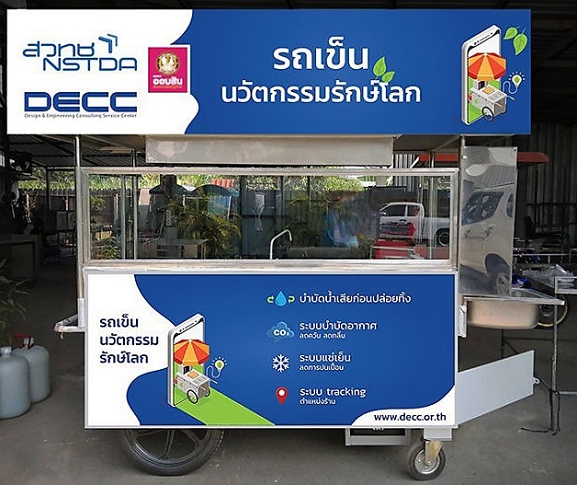
Eco-friendly innovation cart developed by the Design and Engineering Consulting Service Center in collaboration with NSTDA
The survey has identified two prevalent categories of ice cream carts utilized by roadside vendors: 3-wheel carts powered by human power and sidecar motorcycles, which are fabricated in a traditional manner, employing structural elements constructed from low-grade steel, thereby rendering them susceptible to corrosion and lacking in durability (Figure 3). This condition stems from their affordability, which necessitates compromises in quality. Consequently, vendors find themselves constrained in their choices. A subset of these carts has undergone modifications to enhance functionality and visual appeal, including the addition of supplementary structures, expansion of the usable surface area, attachment of promotional apparatus, signage, branding elements, and illumination features. It is pertinent to note that these modifications contravene the stipulations of the Thailand Legal Motor Vehicle Act of 2021. The act explicitly prescribes dimensional limits for wheelchairs and sidecars, mandating that their dimensions must not exceed 1.1 m width, 1.75 m length, and 2 m height. Moreover, in instances where these contraptions are towed by motorcycles, the act further dictates that the width measurement should extend from the outermost periphery of the rear wheel to the outer edge of the trailer wheel, with this measurement not surpassing 1.50 m, as elucidated in Figure 4.

Layout and size of street food carts domestically produced, according to the Thailand Legal Motor Vehicle Act, 2021
In light of the aforementioned reasons, this study proposes an ice cream cart design and development using automobile scraps to bolster the prospects of nascent street food vendors embarking on entrepreneurial ventures, commonly referred to as start-ups. The objectives of this study are 1) to study street food carts, ice cream carts, and other products made from automobile scraps, 2) to design and develop ice cream carts made from automobile scraps to promote start-ups for beginners, and 3) to explore the opinions and satisfaction of ice cream vendors and ice cream buyers towards the prototype of an ice cream cart made from automobile scraps. This innovative intervention is envisioned to yield multifaceted advantages, encompassing enhanced functionality, aesthetically appealing attributes, heightened visibility to attract customers, and a palpable contribution to environmental sustainability.
2. Conceptual Framework
The research conceptual framework drew from established design principles, integrating key concepts proposed by renowned figures in the fields of industrial design and sustainability. It incorporated Henry Dreyfus’ seminal work “Design for People” (Dreyfus, 1967), which encompasses five fundamental formulas: utility and practical functionality, aesthetic appearance, durability and ease of maintenance, product cost, and sales appeal. This framework was complemented by Rachel Cooper’s “green design principles” (Cooper, 2001), which emphasize material consciousness, maximizing product life, designing for recyclability, and energy consciousness. To evaluate user satisfaction, the framework integrated the “user satisfaction framework” proposed by Hayes (2010), encompassing facets including beauty appearance, usability and convenience, durability, safety and ease of maintenance, environmental conservation, reasonable product pricing, and sales appeal. These combined principles created a robust foundation for the design and development of ice cream carts constructed from upcycled automobile scraps, aligning them with modern design standards and sustainable practices and thereby enhancing their viability in contemporary contexts.
3. Method
3. 1. Population and Sample Groups
The research population comprised street food vendors, specifically small-scale entrepreneurs initiating their start-up ventures within the geographic areas of Chaeng Watthana, Lak Si, Don Mueang, Sai Mai, Khan Na Yao, and Min Buri in Bangkok. The total population under consideration amounted to 300 people. The research sample was characterized by a new generation of street food vendors, aged between 25 and 35 years, possessing a minimum educational qualification of a high school diploma or higher. This group aspired to pursue a freelance career yielding monthly incomes ranging from 20,000 to 30,000 Baht. The sampling approach adhered to the principles of purposive sampling, culminating in a representative sample of 100 participants. Additionally, the research included 250 ice cream buyers or consumers chosen through a simple random sampling technique.
3. 2. Variables
The primary research variable pertained to the prototype of an ice cream cart, refined based on the model attaining the highest average score as evaluated by a panel of six experts. The dependent variables comprised usability testing and the satisfaction levels of ice cream vendors, along with the opinions of ice cream consumers toward the prototype of the ice cream cart.
3. 3. Development of Research Tools
The initial phase entailed the formulation of design concepts grounded in principles and theories that underpinned the research’s conceptual framework. Among these concepts, the best three designs were selected for further development.
An expert panel aided in checking the questionnaire, ensuring the accuracy, coherence, and alignment of each question with the research’s objectives. This process was guided by the index of congruence (IOC) to maintain the questionnaire’s accuracy and clarity.
A preliminary survey was executed, distributing questionnaires incorporating the three ice cream cart designs to a cohort of 30 vendors. This survey evaluated aspects including aesthetic appearance, functionality, comfort, safety, durability, ease of maintenance, environmental sustainability, reasonable product price, and sales appeal. The collected data were used for subsequent design development.
The three ice cream cart designs were assessed by six experts: two academic experts in industrial design, two professional design experts, and two experts in manufacturing engineering materials science. Each expert assigned ratings to the designs on a five-point scale, with scores ranging from 4.50 to 5.00 indicating “very good,” 3.50 to 4.49 signifying “good,” 2.50 to 3.49 representing “moderate,” 1.50 to 2.49 characterizing “bad,” and 1.00 to 1.49 denoting “very bad.”
The analysis of the evaluation results from the six experts and the initial opinions of the group of 30 vendors culminated in the selection of the design with the highest average score. This chosen design underwent further refinement to produce technical drawings with dimensions and scales, facilitating the production of a prototype to actual size.
3. 4. Prototyping and Evaluation
A prototype of the ice cream cart, constructed from scrap vehicles, was developed for field testing. This phase entailed gathering feedback and assessing the satisfaction levels and opinions of ice cream vendors and consumers who interacted with the prototype.
3. 5. Data Analysis
Data analysis encompassed the assessment results obtained from the preliminary opinion survey conducted with the group of 100 vendors as well as the evaluation of ice cream cart designs by the expert panel. The analysis involved an explanation and summary of results, leading to design improvements and prototype development. To determine the opinions and satisfaction of vendors and consumers, the prototype was employed in real-world settings, with data collected through the questionnaire and pictures of the real situation. The collected data were recorded, encoded, and processed using the SPSS program. The statistical measures included mean, standard deviation, and percentage, in accordance with the research methodology diagram as depicted in Figure 5.
4. Result
In the pursuit of a design that embodied the essence of “retrospective,” a term evoking nostalgia and memories of days gone by, the research journey commenced with the creation of numerous sketch designs. This term encapsulated anything reminiscent of past impressions and experiences, spanning from childhood to adulthood, that has gracefully weathered the passage of time. The endeavor sought to breathe new life into the cherished memories of yesteryear, endeavoring to revitalize and contemporize them for today’s lifestyle, rekindling their popularity.
Therefore, the researcher has the idea of conveying the historical story. “Design is Story Telling” has passed the passage of time as a reminder that the legend of Thai people was associated with ice cream and trains. These are the concept guidelines for designing the shape and form of the ice cream cart that are related to the shape of a steam locomotive. A steam locomotive was used to travel in Thailand for the first time since 1896 during the reign of King Rama V, and later in 1905, Thailand imported the ice maker machine from Singapore and began experimenting with making ice cream for the first time. Thai people have come to know ice cream as a wonderful food because Thailand has a tropical climate. Therefore, at various train stations, there were street food vendors, including the ice cream that passengers in those days liked to buy and eat while traveling. For this reason, ice cream is one of the most popular food items that has been associated with trains for a long time and is still sold at train stations today. This is the origin from which the concept of “train + ice cream” emerged. This concept served as a conduit for communicating the narrative of past impressions through a retro-style aesthetic, all while ensuring alignment with the principles of cleanliness and orderliness as per the regulations of the year B.E. 2560 and the Motor Vehicle Act B.E. 2564. The outcome of this creative journey resulted in the creation of three distinct designs, represented in Figures 6, 7, and 8.
Concept type A (Figure 6) drew inspiration from the shape of a chariot from 1880–1900. This ice cream cart boasted a width of 1.20 m, a length of 1.90 m, and a height of 1.95 m, complete with a full-length roof. The primary focus for this type was to maximize usable space to meet the needs of selling food and beverages. The place to buy food ready to put in the container (takeaway) had space to store containers and other luggage, size and proportion relative to ergonomic principles, and the modified suspension structure of a small truck. The body frame comprised steel and automotive parts, housing a clean water tank and a wastewater collection system. Illumination was facilitated through name tags and traffic lights, with power sourced from a 45-amp battery.
Concept type B (Figure 7) took its cues from steam locomotives of the 1890s to 1910s during the Machine Age. This ice cream cart featured a roof that covered half of the cart’s dimensions, measuring 1.10 m in width, 1.75 m in length, and 1.85 m in height. The design meticulously considered usable space for food service, accommodating containers (takeaway) and additional storage, adhering to ergonomic principles while minimizing extraneous details for weight reduction. The suspension was adapted from a tricycle cart to a six-wheeled configuration reminiscent of a steam engine. The body of the cart was constructed from steel and automotive components and equipped with clean water and wastewater storage, along with banners and lighting devices powered by a 45-amp battery.
Concept type C (Figure 8) was inspired by locomotive shapes from the late 19th and early 20th centuries. This compact ice cream cart had a 1.10 m width, 1.40 m length, and 1.68 m height, omitting a roof in favor of a foldable umbrella. Its primary function was the sale of ice cream, ready for placement in containers (takeaway). The body was constructed from steel, incorporating automotive scraps and imbuing it with a retro-futuristic style. Ergonomics were considered in the design, providing sufficient space for container and luggage storage while ensuring a lightweight and maneuverable structure. The cart included provisions for clean water and wastewater management, visible banners for point-of-sale prominence, as well as lighting and traffic signs, all powered by a 45-amp battery.
The results of this research data analysis were divided into 3 steps as follows:
Step 1: Design and Development
In this phase, the researcher spearheaded the design of sketch designs for all three types of ice cream carts: type A, type B, and type C. These designs were then evaluated by a cohort of 100 vendors, and the results are summarized in Table 1. It was shown that the preliminary assessment by 100 vendors yielded similar mean scores for types B and C (x̅ = 4.50). Remarkably, both types B and C received high ratings for their aesthetic appearance, with mean scores of 4.56 and 4.60, respectively. Furthermore, they excelled in terms of generating sales appeal, boasting mean scores of 4.55 and 4.58. The lead researcher, therefore, further developed these designs.

Opinions of a group of vendors who evaluated all 3 types of ice cream cart designs: type A, type B, and type C(N = 100)
Step 2: Evaluation by Experts
In this step, the researcher brought the design concepts for the three ice cream cart sketches—type A, type B, and type C—to a panel of six experts for evaluation. The outcomes of this evaluation by experts in academic in industrial design are shown in Table 2. Types B and C received equal total average scores from the two design experts (x̅ = 4.51). Notably, type C garnered the highest mean score (x̅= 4.60) for aesthetic appearance. Additionally, two experts specializing in industrial design rated type C most favorably, achieving an overall mean score of (x̅= 4.50) and excelling in aesthetic appearance with a mean score of (x̅ = 4.56), as shown in Table 3.
According to the data presented in Table 4, it is evident that design type C received the highest total mean score (x = 4.50) in its evaluation by two experts specializing in materials science and production (N = 2). This design was notably praised for its aesthetic appeal, earning the highest average rating (x = 4.56) in terms of aesthetic appearance.

Mean and standard deviation of sketch designs (types A, B, and C) evaluated by two experts in materials science and production(N = 2)
Table 5, which pertained to the design and development stage, revealed that among all three ice cream cart designs, type C garnered the highest mean score (x̅ = 4.50) as assessed by six experts divided into three distinct groups (N = 3).

Opinions of 6 experts in 3 groups (N = 3) evaluating the design of ice cream carts (types A, B, and C)
As shown in Table 6, when considering the assessments from all six experts, ice cream cart type C achieved an average rating of 4.50 across all six evaluation criteria, representing a very good level of satisfaction. Encouraged by these results, the researcher initiated a meticulous review to enhance every detail, ultimately culminating in the creation of detailed working drawings to produce a full-scale prototype, as depicted in Figure 9.

Summary of the mean and standard deviation of six aspects of the design of ice cream cart type C evaluated by six experts organized into three groups(N = 3)
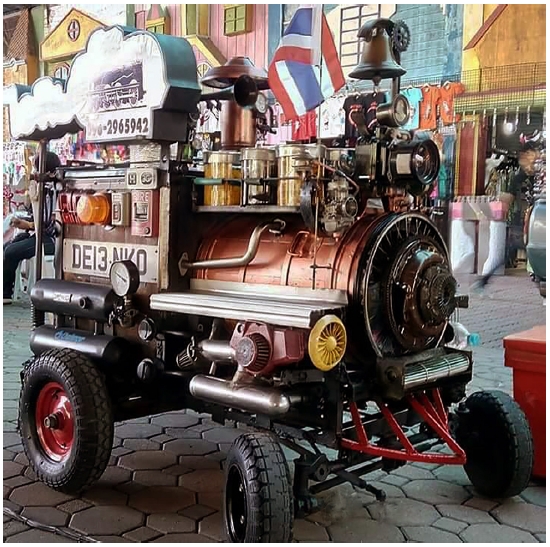
The ice cream cart prototype made of automobile scraps at Thailand Street Food Festival at Safari World Bangkok
Based on the objective of the research, which is recycling scrap car parts, this study created a prototype ice cream truck that catches the eye of consumers. In addition, technicians (Mr. Worapochana Pan-intr) also brought in scrap parts from other vehicles, such as gocart parts, motorcycle parts, wheels, machines that could not be used, and various signs. In this regard, information on the use of various pieces and the process of recycling various items has been presented in Figures 10 and 11 and Table 7.

Modification of scrap car parts and other materials to be used in various positions of the prototype ice cream truck.

Removing leftover car parts and other parts with the recycling process before being made into a prototype ice cream truck.
Step 3: User Satisfaction Assessment
In the final phase, the researcher sought feedback from user groups, consisting of 100 ice cream vendors and 250 ice cream buyers. This assessment involved the utilization of a prototype ice cream cart for real-world ice cream sales scenarios (Figure 12), with the aim of soliciting opinions and evaluating satisfaction levels among both vendors and consumers. The results are shown in Table 8. The results from this phase served as a crucial foundation for refining and finalizing the ice cream cart design
5. Discussion
During the design and development phase, six experts evaluated the C-shaped ice cream cart design across six dimensions, yielding an average score of 4.50, signifying a “very good” level. This outcome aligns harmoniously with the conceptual framework of this research, which incorporated principles from Henry Dreyfuss’ “Designing for People” (Dreyfuss, 1967) and Rachel Cooper’s “Green Design” (Cooper, 2001). Additionally, it resonated with Mark Richardson’s research on “Design for Reuse” (Richardson, 2011), reinforcing the idea that upcycling is a dynamic process integral to sustainable product design (Ahn & Lee, 2018). By embracing this iterative upcycling approach, designers could consciously consider material recyclability throughout the design process, allowing for disassembly and reassembly in the material’s lifecycle.
In Thailand, the current material lifecycle in upcycling design closely resembles that of Korea and Japan, particularly in the realm of repurposing automobile scraps. These materials are recirculated to create new product lifecycles, extending from the second stage through the third, fourth, and even fifth stages, ultimately returning to the cycle as recycled raw materials. This research serves as a practical testament to the viability of sustainable material upcycling, showcasing that upcycling design is not merely a method to manage automobile scraps or vehicle parts but rather a distinct domain of product design that emphasizes creative ingenuity and the enhancement of product value throughout the upcycling process (Panigrahy, R. K., 2020).
The satisfaction assessment, conducted among ice cream vendors and buyers with the prototype ice cream cart, yielded an average score of 4.53, indicating the highest level of satisfaction. This result closely aligned with Bob Hayes’ principles of consumer satisfaction measurement (Hayes, 2010) and Ellen Lupton’s design philosophy that “design was storytelling” (Lupton, 2017), which emphasizes the importance of crafting engaging and compelling narratives through design.
6. Conclusion
The evaluation of ice cream cart vendors and buyers (a total of 350 individuals) towards the prototype of the ice cream cart across all dimensions yielded a remarkable mean score of 4.53, signifying a very high level of satisfaction.
Feedback from ice cream vendors (users) who tested the cart are as follows:
1. The mechanism for turning the left and right of the two front wheels should be improved by relocating the control handle from the back of the cart to the front, akin to a car steering wheel. This adjustment aims to facilitate easier maneuvering in narrow streets or tight spaces.
2. Ice cream vendors expressed a desire to incorporate additional space for a storage tank of ready-made ice cream, such as stick ice cream and cup ice cream, to offer buyers a more extensive variety of ice cream options (approximately 2-3 cubic feet).
7. Limitations and Suggestions
Although this research has yielded valuable insights and contributions, it is essential to acknowledge its limitations and consider potential avenues for future exploration.
Regarding the limitations, the project faced substantial challenges in the handling of automobile scraps, which come in diverse shapes and sizes. This diversity made mass production impractical, as each piece had to be carefully selected and fitted, demanding a significant investment of time, skills, and resources, consequently leading to higher production costs. This aligns with findings from research on “Sustainable design for automotive products: Dismantling and recycling of end-of-life vehicles” (Tian, J., & Chen, M., 2014), which identified challenges in processing certain scrap parts, resulting in incomplete recycling.
Suggestions for future research are as follows:
Streamlining production processes: Future research should explore methods to streamline the production of upcycled products from automobile scraps. Investigating efficient sorting, assembly, or customization techniques could potentially make mass production more feasible and cost-effective.
Market viability: While the custom-made nature of these products is advantageous, research could delve deeper into the market’s willingness to pay for such unique items. Understanding consumer preferences and price sensitivity can provide insights into market viability.
Environmental advocacy: We suggest continuing to promote environmental awareness through upcycled designs and considering collaborative efforts between creators, manufacturers, and users to further the cause of environmental conservation through the promotion of upcycled products.
Diversifying applications: It is essential to explore the adaptability of upcycled designs like the ice cream cart prototype for various purposes beyond street food vending and assess their potential in events, catering, or other service sectors, opening new income streams and market opportunities.
Notes
Copyright : This is an Open Access article distributed under the terms of the Creative Commons Attribution Non-Commercial License (http://creativecommons.org/licenses/by-nc/3.0/), which permits unrestricted educational and non-commercial use, provided the original work is properly cited.
References
- Ahn, S. (2018). Governance Design Strategy Model for Upcycling as Social Innovation. Proceeding of 2018 ADMC Conference (854-870).
-
Ahn, S., & Lee, Y. (2018). Re-Envisioning Material Circulation and Designing Process in Upcycling Design Product Life Cycle. Archives Of Design Research, 31(4), 5-20.
[https://doi.org/10.15187/adr.2018.11.31.4.5]

- Cara, J., & Mike, A. (2002). Materials and design: The Art and Science of Material Selection in Product Design. Italy: Elsevier Ltd.
- Cooper, R. (2001). The Design Agenda. University College Salford, UK and Mike Press Staffordshire University. United Kingdom: John Wiky & Sons Ltd.
- Dreyfuss, H. (1967). Designing for People. New York: Paragraphic Books.
- Fiell, C., & Fiell, P. (2022). Industrial Design A-Z. Koln: Taschen.
- Flinchum, R. (1997). Henry Dreyfuss, Industrial Designer: The Man in the Brown Suit. Italy: Rizzoli.
- Han, S., Tyler, D., & Apeagyei, P. (2015). Upcycling as a design strategy for product lifetime optimisation and societal change. Proceeding of PLATE conference (1-12).
- Hayes, E. (2010). Measuring customer satisfaction and loyalty. Quality Press.
-
Khan, W. S., Asmatulu, E., Uddin, M. N., & Asmatulu, R. (2022). Recycling and reusing of engineering materials: Recycling for sustainable developments. Amsterdam: Elsevier Science Publishing Co Inc.
[https://doi.org/10.1016/B978-0-12-822461-8.00008-5]

-
Krejcie, R. V., & Morgan, D. W. (1970). Determining Sample Size for Research Activities. Educational and Psychological Measurement, 30(3), 607-610.
[https://doi.org/10.1177/001316447003000308]

- Lupton, E. (2017). Design is Story Telling. New York: Cooper Hewitt, Smithsonian Design Museum.
- National Science and Technology Development Agency. (2021). Eco-cart innovation for street food. Retrieved from https://www.bangkokbiznews.com/tech/866532.
- New Delhi: New Age International (P) Ltd.
- Niamsup, N. (2015). Product Shape Design Guidelines Based on Materials "Form Follows Material" - Chulalongkorn University. Retrieved from https://www.yumpu.com/en/document/view/45488586/form-follows-material-.
- Ordonez, I., Khan, A., Tandon, P., & Rexfelt, O. (2016). Designing with waste: comparison of two practice-based education cases. In DS 83: Proceedings of the 18th International Conference on Engineering and Product Design Education (E&PDE16), Design Education: Collaboration and Cross-Disciplinarity, Aalborg, Denmark, 8th-9th September 2016 (pp. 152-157).
-
Panigrahy, R. K. (2020). Upcycling of Scraps from Technical Institutes: A Case Study-Govt. Industrial Training Institute Berhampur. Waste Management as Economic Industry Towards Circular Economy, 85-94.
[https://doi.org/10.1007/978-981-15-1620-7_9]

- Police Lieutenant Nopparat Pimthong. (2021). Laws related to sidecar motorcycles (Sa Leng). Retrieved from https://www.peesirilaw.com/index.php?lay=show&ac=article&Id=538727332&Ntype=40.
- Richardson, M. (2011). Design for reuse: Integrating upcycling into industrial design practice. Proceeding of International Conference on Remanufacturing 2011 (1-13).
- Sharma, P., Sharma, A., Sharma, A., & Srivastava, P. (2016). Automobile waste and its management. Research Journal of Chemical and Environmental Sciences, 4(2), 1-7.
-
Tian, J., & Chen, M. (2014). Sustainable design for automotive products: Dismantling and recycling of end-of-life vehicles. Waste management, 34(2), 458-467.
[https://doi.org/10.1016/j.wasman.2013.11.005]

- Tseng, S. C. W. (2023). Canadian Automotive Recycling Industry: Developing Towards a Circular Economy (Doctoral dissertation). University of Windsor (Canada).
- Wangboonkongchana, T. (2022). The Prime Minister encourages recycling of old cars, reducing PM2.5 and reducing steel imports from abroad. Retrieved from https://workpointtoday.com/cars-over-20-years-old/.
-
XU, J., & Gu, P. (2015). Five Principles of Waste Product Redesign under the Upcycling Concept. International Forum on Energy, Environment Science and Materials (IFEESM 2015). Amsterdam: Atlantis.
[https://doi.org/10.2991/ifeesm-15.2015.227]



